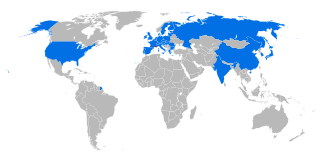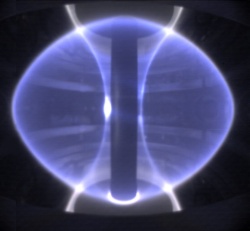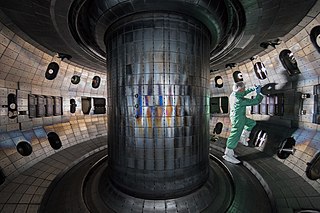
A tokamak is a device which uses a powerful magnetic field to confine a hot plasma in the shape of a torus. The tokamak is one of several types of magnetic confinement devices being developed to produce controlled thermonuclear fusion power. As of 2016, it is the leading candidate for a practical fusion reactor.

ITER is an international nuclear fusion research and engineering megaproject, which will be the world's largest magnetic confinement plasma physics experiment. It is an experimental tokamak nuclear fusion reactor that is being built next to the Cadarache facility in Saint-Paul-lès-Durance, in Provence, southern France.

A reversed-field pinch (RFP) is a device used to produce and contain near-thermonuclear plasmas. It is a toroidal pinch which uses a unique magnetic field configuration as a scheme to magnetically confine a plasma, primarily to study magnetic fusion energy. Its magnetic geometry is somewhat different from that of the more common tokamak. As one moves out radially, the portion of the magnetic field pointing toroidally reverses its direction, giving rise to the term "reversed field". This configuration can be sustained with comparatively lower fields than that of a tokamak of similar power density. One of the disadvantages of this configuration is that it tends to be more susceptible to non-linear effects and turbulence. This makes it a perfect laboratory for non-ideal (resistive) magnetohydrodynamics. RFPs are also used in the study of astrophysical plasmas as they share many features.

The Tokamak Fusion Test Reactor (TFTR) was an experimental tokamak built at Princeton Plasma Physics Laboratory (PPPL) circa 1980 and entering service in 1982. TFTR was designed with the explicit goal of reaching scientific breakeven, the point where the heat being released from the fusion reactions in the plasma is equal or greater than the heating being supplied to the plasma by external devices to warm it up.

The Mega Ampere Spherical Tokamak (MAST) experiment was a nuclear fusion experiment in operation at Culham Centre for Fusion Energy, Oxfordshire, England, from December 1999 to September 2013.
The Small Tight Aspect Ratio Tokamak, or START was a nuclear fusion experiment that used magnetic confinement to hold plasma. START was the first full-sized machine to use the spherical tokamak design, which aimed to greatly reduce the aspect ratio of the traditional tokamak design.

DIII-D is a tokamak that has been operated since the late 1980s by General Atomics (GA) in San Diego, USA, for the U.S. Department of Energy. The DIII-D National Fusion Facility is part of the ongoing effort to achieve magnetically confined fusion. The mission of the DIII-D Research Program is to establish the scientific basis for the optimization of the tokamak approach to fusion energy production.

The Experimental Advanced Superconducting Tokamak (EAST), internal designation HT-7U, is an experimental superconducting tokamak magnetic fusion energy reactor in Hefei, China. The Hefei-based Institute of Plasma Physics is conducting the experiment for the Chinese Academy of Sciences. It has operated since 2006. It was later put under control of Hefei Institutes of Physical Science.
HT-7, or Hefei Tokamak-7, is an experimental superconducting tokamak nuclear fusion reactor built in Hefei, China, to investigate the process of developing fusion power. The HT-7 was developed with the assistance of Russia, and was based on the earlier T-7 tokamak reactor. The reactor was built by the Hefei-based Institute of Plasma Physics under the direction of the Chinese Academy of Sciences.

The KSTAR is a magnetic fusion device at the National Fusion Research Institute in Daejeon, South Korea. It is intended to study aspects of magnetic fusion energy which will be pertinent to the ITER fusion project as part of that country's contribution to the ITER effort. The project was approved in 1995 but construction was delayed by the East Asian financial crisis which weakened the South Korean economy considerably; however the construction phase of the project was completed on September 14, 2007. The first plasma was achieved in June 2008.
The Enormous Toroidal Plasma Device (ETPD) is an experimental physics device housed at the Basic Plasma Science Facility at UCLA. It previously operated as the Electric Tokamak (ET) between 1999 and 2006 and was noted for being the world's largest tokamak before being decommissioned due to the lack of support and funding. The machine was renamed to ETPD in 2009. At present, the machine is undergoing upgrades to be re-purposed into a general laboratory for experimental plasma physics research.

ASDEX Upgrade is a divertor tokamak, that went into operation at the Max-Planck-Institut für Plasmaphysik, Garching in 1991. At present, it is Germany's second largest fusion experiment after stellarator Wendelstein 7X.
SUNIST, the abbreviation of Sino-UNIted Spherical Tokamak, is a small spherical tokamak in the Department of Engineering Physics, Tsinghua University, Beijing, China.

The Pegasus Toroidal Experiment is a plasma confinement experiment relevant to fusion power production, run by the Department of Engineering Physics of the University of Wisconsin–Madison. It is a spherical tokamak, a very low-aspect-ratio version of the tokamak configuration, i.e. the minor radius of the torus is comparable to the major radius.

A spherical tokamak is a type of fusion power device based on the tokamak principle. It is notable for its very narrow profile, or aspect ratio. A traditional tokamak has a toroidal confinement area that gives it an overall shape similar to a donut, complete with a large hole in the middle. The spherical tokamak reduces the size of the hole as much as possible, resulting in a plasma shape that is almost spherical, often compared with a cored apple. The spherical tokamak is sometimes referred to as a spherical torus and often shortened to ST.
The ISTTOK Tokamak is a research fusion reactor (tokamak) of the Instituto Superior Técnico. It has a circular cross-section due to a poloidal graphite limiter and an iron core transformer. Its particularity is that it is one of the few tokamaks operating in AC regime, as well in DC regime. In 2013, the AC operation allowed the standard discharges to extend from 35 ms to more than 1s.
The Spherical Tokamak Experiment is a machine dedicated to plasma studies in low aspect ratio tokamaks. The ETE was entirely designed and assembled at the Associated Plasma Laboratory of Brazil's National Institute for Space Research (INPE).

Tokamak COMPASS is the main experimental facility of Tokamak department of Institute of Plasma Physics of the Academy of Sciences of the Czech Republic since 2006. It was designed in the 1980s in the British Culham Science Centre as a flexible research facility dedicated mostly to plasma physics studies in circular and D shaped plasmas.
The China Fusion Engineering Test Reactor (CFETR) is a proposed tokamak nuclear fusion reactor in China.
CFETR construction is planned for the 2020s as a demonstration of the feasibility of large scale fusion power generation.












